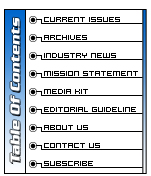|
GPS Q&A Q I've heard about pen-based mapping systems as a form of GIS data collection. What advantages does such a system provide? A Pen-based mapping systems provide a wealth of advantages for GIS data collection. Due to continued advancements in the speed, size, and portability of field computers, users have more tools at their fingertips then ever before. Pen systems are primarily designed to meet the special needs of field data collection. Some types of data collection incorporate the use of GPS. These pen systems get their name from the pen-stylus used to interface with the computer. This allows the user to interact within a Windows environment (3x, 9x, NT, or CE) much like they would with a mouse in the office. By tapping the computer screen with the stylus, users can perform a variety of tasks. The field computer is quite similar to modern laptops in terms of processor speed and storage capabilities. Physical keyboards are not necessary, as handwriting recognition has become the standard. Since the field computer has more processing power than traditional data collectors do, it can provide additional tools for GIS data collection.
When used in conjunction with real-time, single-frequency GPS, pen systems become real-time data collectors. As a GIS tool, this type of configuration provides users with accuracy suitable for most GIS requirements; typically sub-meter to 2m, depending on which real-time solution you employ. And, with a real-time component, only one receiver is required, so there is no need to purchase additional receivers for post processing.
With a more powerful computer in the field, good data collection software should be capable of allowing users to interact with their field data more proficiently. One of the advantages is being able to interact with data graphically as it is collected. This means that, while you are acquiring point, line, and area features, you can see the features and the map they create as it is being drawn in the field. There is a remarkable value in being able to visually check your data and make edits while still in the field, rather than back at the office. Think of it as a form of real-time quality control.
Another tool available allows users to work 'on top of' existing data sets. Previously collected data sets or images, such as aerial photography, satellite imagery, and plat maps may be loaded into the background to provide valuable visual cues. Instead of bringing paper maps to the field, digital versions of these maps can be used as a field reference for the GIS field data.
Most importantly, data integrity is substantially improved. Not only are edits made in the field, thereby removing this task from the office, but also errors caused by transcribing data are eliminated. This functionality, along with the ability to edit spatial and aspatial aspects of your GIS data sets, means that fewer trips back to the field are required to recollect the same data.
While GPS is the most common sensor used with pen computers and mapping software, other devices may also be used either exclusively, or as a supplement to extend the use of the GPS system. For instance, GPS has limitations in urban canyons or forested areas because the view of the satellites is compromised. By using a laser range finder to provide a distance and azimuth offset, users can reliably use GPS from a 'friendly' environment. Additionally, survey grade GPS, binoculars, and manual data collection methods may be employed for other types of surveys. Here, the pen system serves as a universal data collector.
Recent developments in computer hardware, software, and GPS solutions have made pen mapping solutions more viable today then ever before. By integrating a pen solution with GPS, total stations, laser range finders, and the like, the advantages of this technology are far reaching. Use it to improve GIS collection efficiency, save money, and improve your bottom line.
Back
|

